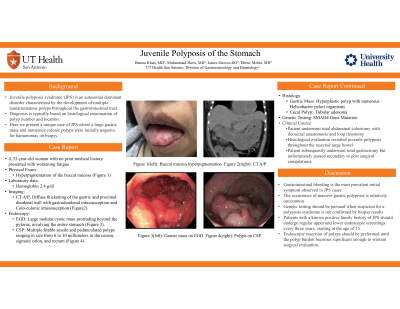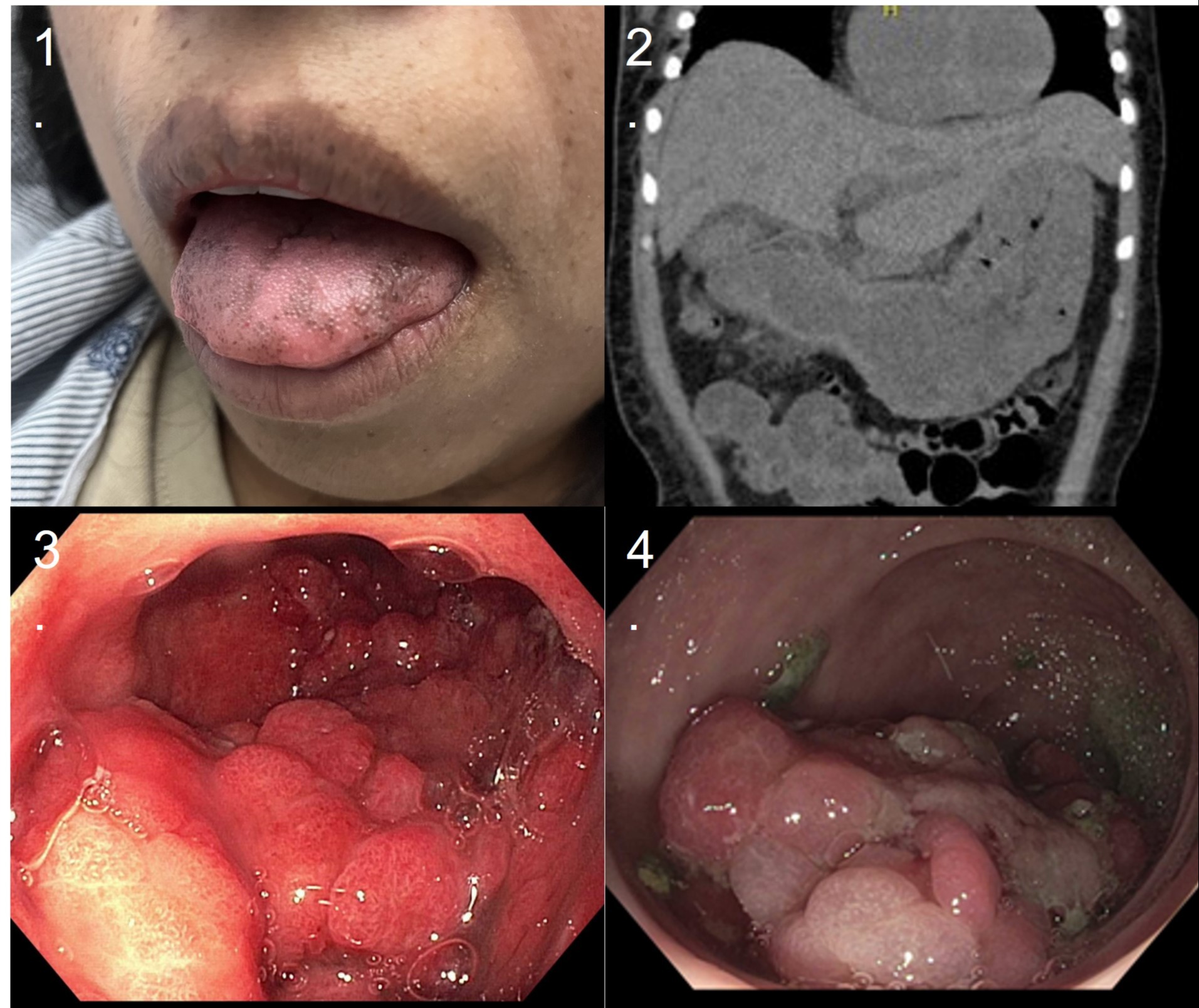Monday Poster Session
Category: Stomach
P2768 - Juvenile Polyposis of the Stomach
Monday, October 23, 2023
10:30 AM - 4:15 PM PT
Location: Exhibit Hall

Has Audio

Hamza Khan, MD
UT Health San Antonio
San Antonio, TX
Presenting Author(s)
Hamza Khan, MD1, Muhammad Haris, MD1, James Gnecco, DO2, Benjamin Heriford, DO2, Jonathan Selzman, DO2, Umar Siddiqui, DO3, Keerthi Thallapureddy, MD1, Dakota Bigham, MD3, Aliya Sharif, MD1, Dhruv Mehta, MD1
1UT Health San Antonio, San Antonio, TX; 2University of Texas Health Science Center at San Antonio, San Antonio, TX; 3University of Texas Health Science Center-San Antonio, San Antonio, TX
Introduction: Juvenile polyposis syndrome (JPS) is a rare autosomal dominant disorder characterized by the development of multiple hamartomatous polyps throughout the gastrointestinal tract. Diagnosis is typically based on histological examination of polyp number and location. In this case report, we present a unique case of JPS where a large gastric mass and numerous colonic polyps were initially negative for hamartomas on biopsy.
Case Description/Methods: A 33-year-old woman with no prior medical history presented with worsening fatigue and was diagnosed with severe iron deficiency anemia (hemoglobin: 2.4). Physical exam revealed hyperpigmentation of the buccal mucosa (Figure 1). Computed tomography of the abdomen and pelvis revealed diffuse thickening of the gastric and proximal duodenal wall with gastroduodenal intussusception. Colo-colonic intussusception was also noted (Figure2) Esophagogastroduodenoscopy identified a large nodular cystic mass protruding beyond the pylorus, involving the entire stomach (Figure 3). Colonoscopy revealed multiple friable sessile and pedunculated polyps ranging in size from 6 to 30 millimeters in the cecum, sigmoid colon, and rectum (Figure 4). Microscopic examination of the stomach mass revealed a hyperplastic polyp with numerous Helicobacter pylori organisms. Biopsy of the cecal polyps showed tubular adenomas while the sigmoid polyp was hyperplastic. Subsequent genetic testing revealed a SMAD4 gene mutation, confirming the diagnosis of juvenile polyposis syndrome (JPS). The patient underwent total abdominal colectomy with ileorectal anastomosis and loop ileostomy. Histological evaluation revealed juvenile polyposis throughout the resected large bowel. Due to frequent gastric outlet obstructions, surgical oncology plans to perform a total gastrectomy in the near future.
Discussion: Gastrointestinal bleeding is the most prevalent initial symptom observed in JPS cases. While various forms of JPS have been described, the occurrence of massive gastric polyposis is relatively uncommon. Genetic testing should be pursued when suspicion for a polyposis syndrome is not confirmed by biopsy results, as seen in this case. Patients with a known positive family history of JPS should undergo regular upper and lower endoscopic screenings every three years, starting at the age of 15. Endoscopic resection of polyps should be performed until the polyp burden becomes significant enough to warrant surgical evaluation.

Disclosures:
Hamza Khan, MD1, Muhammad Haris, MD1, James Gnecco, DO2, Benjamin Heriford, DO2, Jonathan Selzman, DO2, Umar Siddiqui, DO3, Keerthi Thallapureddy, MD1, Dakota Bigham, MD3, Aliya Sharif, MD1, Dhruv Mehta, MD1. P2768 - Juvenile Polyposis of the Stomach, ACG 2023 Annual Scientific Meeting Abstracts. Vancouver, BC, Canada: American College of Gastroenterology.
1UT Health San Antonio, San Antonio, TX; 2University of Texas Health Science Center at San Antonio, San Antonio, TX; 3University of Texas Health Science Center-San Antonio, San Antonio, TX
Introduction: Juvenile polyposis syndrome (JPS) is a rare autosomal dominant disorder characterized by the development of multiple hamartomatous polyps throughout the gastrointestinal tract. Diagnosis is typically based on histological examination of polyp number and location. In this case report, we present a unique case of JPS where a large gastric mass and numerous colonic polyps were initially negative for hamartomas on biopsy.
Case Description/Methods: A 33-year-old woman with no prior medical history presented with worsening fatigue and was diagnosed with severe iron deficiency anemia (hemoglobin: 2.4). Physical exam revealed hyperpigmentation of the buccal mucosa (Figure 1). Computed tomography of the abdomen and pelvis revealed diffuse thickening of the gastric and proximal duodenal wall with gastroduodenal intussusception. Colo-colonic intussusception was also noted (Figure2) Esophagogastroduodenoscopy identified a large nodular cystic mass protruding beyond the pylorus, involving the entire stomach (Figure 3). Colonoscopy revealed multiple friable sessile and pedunculated polyps ranging in size from 6 to 30 millimeters in the cecum, sigmoid colon, and rectum (Figure 4). Microscopic examination of the stomach mass revealed a hyperplastic polyp with numerous Helicobacter pylori organisms. Biopsy of the cecal polyps showed tubular adenomas while the sigmoid polyp was hyperplastic. Subsequent genetic testing revealed a SMAD4 gene mutation, confirming the diagnosis of juvenile polyposis syndrome (JPS). The patient underwent total abdominal colectomy with ileorectal anastomosis and loop ileostomy. Histological evaluation revealed juvenile polyposis throughout the resected large bowel. Due to frequent gastric outlet obstructions, surgical oncology plans to perform a total gastrectomy in the near future.
Discussion: Gastrointestinal bleeding is the most prevalent initial symptom observed in JPS cases. While various forms of JPS have been described, the occurrence of massive gastric polyposis is relatively uncommon. Genetic testing should be pursued when suspicion for a polyposis syndrome is not confirmed by biopsy results, as seen in this case. Patients with a known positive family history of JPS should undergo regular upper and lower endoscopic screenings every three years, starting at the age of 15. Endoscopic resection of polyps should be performed until the polyp burden becomes significant enough to warrant surgical evaluation.

Figure: Figure 1: Buccal mucosa hyperpigmentation. Figure 2: CT A/P with diffuse thickening of the gastric and duodenal wall. Figure 3: Gastric mass. Figure 4: Colonic polyposis.
Disclosures:
Hamza Khan indicated no relevant financial relationships.
Muhammad Haris indicated no relevant financial relationships.
James Gnecco indicated no relevant financial relationships.
Benjamin Heriford indicated no relevant financial relationships.
Jonathan Selzman indicated no relevant financial relationships.
Umar Siddiqui indicated no relevant financial relationships.
Keerthi Thallapureddy indicated no relevant financial relationships.
Dakota Bigham indicated no relevant financial relationships.
Aliya Sharif indicated no relevant financial relationships.
Dhruv Mehta indicated no relevant financial relationships.
Hamza Khan, MD1, Muhammad Haris, MD1, James Gnecco, DO2, Benjamin Heriford, DO2, Jonathan Selzman, DO2, Umar Siddiqui, DO3, Keerthi Thallapureddy, MD1, Dakota Bigham, MD3, Aliya Sharif, MD1, Dhruv Mehta, MD1. P2768 - Juvenile Polyposis of the Stomach, ACG 2023 Annual Scientific Meeting Abstracts. Vancouver, BC, Canada: American College of Gastroenterology.
